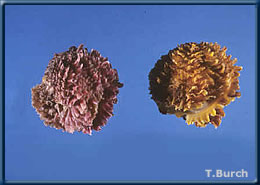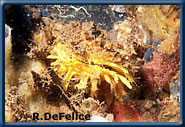

Anomia nobilis

Crassostrea virginica

Chama macerophylla

Crucibulum spinosum
Chama macerophylla
 Rock
oyster
Rock
oyster
Phylum Mollusca
Class Bivalvia
Family Chamidae
Description
Brightly colored, heavy shelled bivalve with long, ribbed, leafy projections
in radiating rows. Most commonly, yellow or orange, but some pinkish individuals
may be found. Inside is white. May grow to about 10 cm in diameter. This
species lives fixed to the substrate with one shell valve cemented in
place. They are highly variable in form, with the lower valve conforming
to the shape of the substrate and upper, exposed valve becoming very worn
losing color and sculpture.
Habitat
 Individuals
always live attached to hard substrate, adults can only be removed with
hammer and chisel. In Hawaii, this species was found to be abundant on
the hull of a floating dry-dock in Pearl Harbor, and two nearby collecting
statiions. So far it has not been reported outside od Pearl Harbor.
Individuals
always live attached to hard substrate, adults can only be removed with
hammer and chisel. In Hawaii, this species was found to be abundant on
the hull of a floating dry-dock in Pearl Harbor, and two nearby collecting
statiions. So far it has not been reported outside od Pearl Harbor.
Distribution
Hawaiian Islands
Known only from Pearl Harbor, Oahu
Native Range
Caribbean
Present Distribution
Caribbean and Pearl Harbor, Oahu
Mechanism of Introduction
Unintentional, as fouling on ships' hull
Impact
A stubborn fouling species; adult bivalves are very difficult to remove
from ships hulls. Ecological impact unstudied, but presumed minimal.
Ecology
Feeding
Bivalves are suspension feeders. Water is moved through an incurrent siphon
into the mantle cavity by cilia on the ctenidia (gills). Water passes
over the ctenidia, food particles are extracted by the cilia, and water
is expelled through an exhalent siphon.
Reproduction
Reproduction in this species is unstudied. Bivalves are typically gonochoristic
(having separate male and female individuals), fertilization is external,
and the developing larvae (veliger) settle to the bottom after a time
in the plankton.
Remarks
The variability in the form of the shell is the primary cause of the confused
systematics within the Chamoidea. First reported in Hawaii as the Red
Sea species, Chama elatensis Delsaerdt, 1986, by Coles et al. (1999) in
Pearl Harbor, we now tentatively apply the name C. macerophylla to these
specimens (G. Paulay, pers. comm.). This species was previously known
only from the Caribbean.
References
Coles, S.L., R.C. DeFelice, L.G. Eldredge and J.T. Carlton. 1999. Historical
and recent introductions of nonindigenous marine species into Pearl Harbor,
Oahu, Hawaiian Islands. Marine Biology. 135: 147-158.
© 2002 Hawaii Biological Survey, Bishop Museum
contact